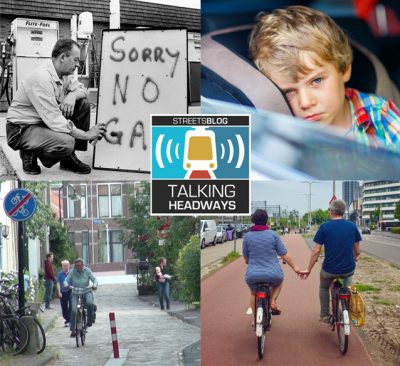This week we're joined by Melissa and Chris Bruntlett to talk about their book, "Curbing Traffic: The Human Case for Fewer Cars in Our Lives." We chat about the ambient stress and anxiety created by auto-oriented cities, the mental energy saved by car-light spaces, and the difference between engineering and ecological resilience.
For those of you who prefer to read rather than to listen, check out an edited transcript below the audio player. For the unedited full podcast, click here.
?
Jeff Wood: You all have talked about the book a lot, I’m sure you’ve done a number of interviews and written pieces for a number of outlets. What’s something that you all wish more people wanted to know about the book or the topic?
Melissa Bruntlett: That's a great question. We do talk about it a bit, but I think for me writing this book was really about communicating the mental-health benefits. I think much more energy should be spent on how high-traffic, high-stress cities, really impact the mental health of everyone. So, for young children, one of the stats we talked about in the book is that the kids in the U.S. are traveling longer distances to school and are constantly tired because they have to get up earlier and then get to activities. This is having a significant impact on their mental health and their anxiety levels and increasing depression. You know, this is really important when we’re talking, you know, so many of us have kids or know of kids that are, are dealing or struggling with these mental illnesses.
I don’t think we make that connection often enough, be that for children or any age or ability, the connection between how transportation really has that impact on how our brains function healthily. So that was one of the reasons I really wanted to write this book is to help communicate that to a lot of people, because I think it’s really important and really benefits everyone. I mean, we all experience stress, anxiety, various levels of depression. If our cities can help to mitigate some of that in terms of how we move through it or how other people move around us, I think is a benefit to society as a whole.
Chris Bruntlett: The book’s only been out two months now. The chapter that’s got the least attention and the least number of questions has been Ch. 9, "The Resilient City," which is very interesting, especially given the timing of the book, being written and released around the COVID pandemic, because it really changed the way we approached that chapter. We had pitched it to Island Press before the pandemic happened, but much of the research and the experiences we write about were informed by the way the world was locked down for months and months and a lot of cities scrambled to change their streets and create more walking and cycling space and dining space on the streets and parking lots.
But, unfortunately, there’s been very little discussion about the moment in which we find ourselves and how that may have changed the thinking of the population, how that might’ve changed how politicians are thinking, because we hope and think that it may be an inflection point for a lot of cities in terms of seeing how it can be different, seeing how quickly the change can come. Suddenly, as the Netherlands did in the 1970s oil crisis, completely pivot to not a car-free society, but a more varied and balanced approach to street design and transportation design. But, yeah, I think disappointed maybe a bit strong, but I think we’ve been surprised at how little this conversation is taking place.
Cities are seemingly wanting to bounce back to the status quo, and you’re seeing it now with the infrastructure bill in the United States. They’re about to spend billions and billions on highways and widening as if this pandemic never happened. As we look ahead to well climate change and the impact that’s having in terms of extreme weather, fuel shortages, we saw highways flooded in Detroit, like surely this has to have an impact at some point the way we approach these investments. But we haven’t seen unfortunately very much evidence of it at this moment in time.






